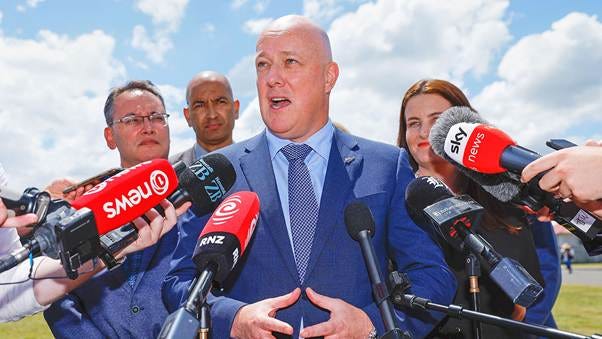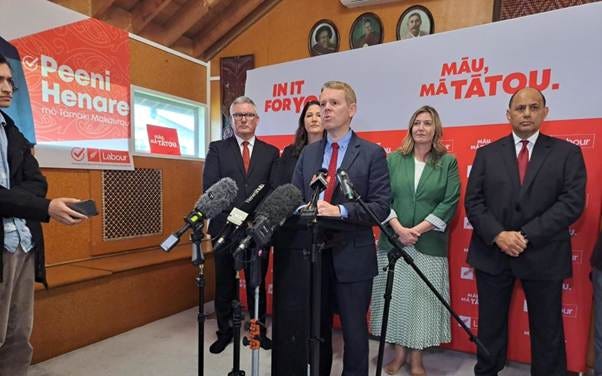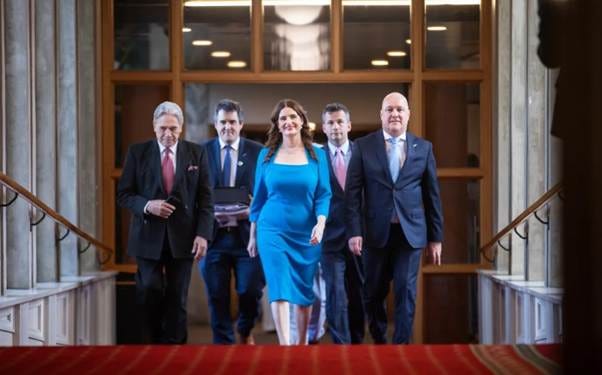We are the goon squad and we're coming to town
Beep-beep, beep-beep
(David Bowie – Fashion – 1980)
One of the regular features of the political landscape is the “media stand-up” – a relatively formalized opportunity for a politician to put forward a new policy or deal with a current issue. The usual way of communicating a political position in a relatively formalized setting was by way of a press conference but there are differences between a press conference and a media stand-up.
Stand-Up or Press Conference
The difference between a media stand-up and a press conference lies in their formality, structure, duration, and purpose. Though both are mechanisms for public communication with the press and media, they serve different strategic and logistical functions.
The media stand-up is usually portrayed as informal and often impromptu, but in reality they are not. They have become carefully stage-managed events. They are typically held in open or transitional spaces—outside Parliament, on the street, in a corridor, or at an event venue. The speaker stands, usually without a podium, and may be flanked by supporters or officials for visual effect. (More on this aspect later)
On the other hand a press conference (or “presser”) is more formal and planned in advance. It is usually held in a dedicated setting such as a briefing room, media centre, or stage. There is often a podium, backdrop, and sometimes a moderator or structured agenda.
A media stand-up is generally brief—often just a few minutes. It is designed for quick statements or sound bites. Questions are typically limited, and the interaction is short whereas a press conference is longer-ranging from 15 minutes to over an hour. This allows for more in-depth questions, multiple speakers, and sometimes presentations or briefings.
The media stand-up offers the speaker more control. They may make a short statement and take only a few questions—or none. The stand-up can be used to manage media exposure while avoiding sustained scrutiny.
The press conference is more structured, but also more exposed. Journalists usually have more time and freedom to ask follow-up questions, and the speaker is expected to engage more thoroughly.
The media stand-up is often used for reactive or symbolic communication— responding to breaking news, making a quick statement, or delivering a targeted message with a visual backdrop. They are common during political campaigns, parliamentary sessions, or crisis situations.
Press conferences on the other hand are used for proactive, formal announcements or substantive discussions—e.g., policy launches, major decisions, crisis briefings, or official statements from institutions or experts.
The Stand-Up Examined
The media stand-up has become a staple of contemporary democratic life. Yet behind its performative informality lies a deeply evolved and tactical phenomenon.
The origins of the modern media stand-up can be traced to the emergence of mass media and the institutionalisation of press access in the 20th century. While leaders have always communicated with the public, the ad hoc press interaction in the open air began to crystallize with the advent of television and portable broadcast technology in the 1950s and 60s.
During the Kennedy presidency, impromptu interviews and press availabilities outside the White House or on the tarmac of Andrews Air Force Base became a recurring feature, reinforcing Kennedy’s image as charismatic and transparent. However, the actual roots lie deeper—in the press “scrums” and “gaggles” that formed outside courthouses, legislative chambers, and political conventions, as early as the 19th century.
What distinguishes the modern stand-up is its visuality: the calculated backdrop, the clustering of allies or officials behind the speaker, and the symbolism encoded in setting and posture. With the maturation of television as a medium, the stand-up evolved into both a communicative and symbolic act.
At face value, the media stand-up signals accessibility and responsiveness—a leader or official stepping briefly from the corridors of power to speak directly, and seemingly informally, to the press. But its meaning extends far beyond this superficial message.
In terms of the use of signs and symbols (the study of which is semiotics), the stand-up functions as a ritual of performative legitimacy. The speaker occupies a liminal space—neither within the closed confines of Parliament nor the fully private realm of party caucuses. This liminality evokes a sense of public accountability while carefully avoiding the more rigorous scrutiny of formal interviews or long-form journalism.
Moreover, the presence of flanking figures—a phenomenon increasingly common—imbues the event with layers of meaning: solidarity, institutional authority, and consensus. Whether ministers, party members, or bureaucratic staffers, these figures serve as silent affirmers of the speaker’s message, invoking a visual grammar of credibility.
The questions asked by journalists—whether answered or deftly dodged—further contribute to a narrative of democratic dialogue. Even when evasive, the speaker appears to engage, thus upholding the ritual of accountability, if not its substance.
Despite the ostensible openness of the stand-up, its true purpose is often strategic control. It allows political actors to frame issues on their own terms, to float trial balloons, or to neutralize emerging controversies with pre-emptive sound bites.
Unlike press conferences, which invite prolonged interrogation, the stand-up is a calibrated moment of message dissemination. Time is limited, and the setting can be leveraged to curtail questions or deflect scrutiny—e.g., a noisy street, a narrow hallway, or a factory floor with symbolic industrial resonance.
More profoundly, the media stand-up serves the rhythmic requirements of modern news cycles. In an era of 24/7 media saturation, regular stand-ups generate footage, quotes, and content that feed the machinery of reportage and commentary. For the speaker, it is an opportunity to insert preferred language into headlines, and thus to shape public discourse.
In crisis situations, the stand-up functions as damage control - a means of appearing engaged without revealing much, of showing up without being cornered. Its brevity and ambiguity can be virtuous. To the casual observer, it may seem an incidental encounter between power and press. Yet for the political strategist, journalist, and media theorist alike, the stand-up is a microcosm of the dynamic interplay between visibility, authority, and message discipline in contemporary democracy. Like all theatre, it reveals much - particularly when it pretends to reveal nothing – or alternatively the goal may be to deflect rather than disclose.
One of the important elements of the stand-up, which I have highlighted above, is the presence of flanking figures – often Ministers and officials. They serve a number of purposes although they rarely say anything and often nod sagely demonstrating unwavering agreement with what the principal speaker is saying.
But it has become so much of the performative aspect of the stand-up that one must question whether a politician might do a stand-up solo. Some do. But in the main the flankers are there.
We have become used to the presence – indeed the requirement – of support persons. I used to encounter them frequently in Court. A support person was required by a witness to be present during testimony. And that was more than reasonable. A Courtroom is an intimidating place at the best of times.
But are support persons necessary for a politician at a media stand-up? The purpose, as stated above, is performative. It provides positive optics – the illusion of solidarity.
A backdrop of people signals that the speaker's position is not personal or isolated, but backed by others—party members, community leaders, or stakeholders, and numbers suggest momentum and institutional support, reinforcing the legitimacy of the announcement.
From a PR perspective optics matter. Visuals are powerful in media. A group standing behind the speaker can convey "broad-based support" even if they don't speak. In addition, in the quest for diversity, politicians often include individuals from various ethnicities, age groups, or professions to send a message of inclusivity and broad appeal.
It could be suggested that the presence of the “flankers” reinforces credibility. Standing with experts (e.g., health officials during a pandemic) or uniformed personnel (e.g., police or military) lends gravitas and underscores seriousness and especially during crises, the presence of officials projects competence, coordination, and calm.
If the policy or decision is controversial, sharing the stage implies it was a decision made collectively signalling that implementation will involve multiple parties, not just the person speaking.
It must be remembered that politics involves managing perception. A staged announcement with a crowd gives the impression of momentum or consensus and even without speaking, those present serve as nonverbal validators.
But what truly practical purpose do these supporters serve, other than having time taken out of their day when they could be doing something productive, if indeed that is what politicians do.
My late father had a scatological explanation which involved having another person holding the male organ during urination, but his language was more acerbic and elementary than that.
But it was another family member who was watching a news broadcast a few years ago who made the comment – “There he is, with the Goon Squad”.
And now that term has become the “go-to” phrase when I see a media standup with the flanking characters.
The Goon Squad.
Probably the wrong term from an etymological perspective. My reasons for saying that are these.
The Goon Squad
A goon squad is a group of people, often composed of hired criminals, detectives, or mercenaries, formed to intimidate and assault a specific group of opponents, most often unionized workers.
During the labor unrest of the late 19th century in the United States, businessmen hired goon squads composed of Pinkerton agents to infiltrate unions, and as guards to keep strikers and suspected unionists out of factories.
One of the best known such confrontations was the Homestead Strike of 1892, in which Pinkerton agents were called in to enforce the strikebreaking measures of Henry Clay Frick, acting on behalf of Andrew Carnegie, who was abroad; the ensuing conflicts between Pinkerton agents and striking workers led to several deaths on both sides.
The Pinkertons were also used as guards in coal, iron, and lumber disputes in Illinois, Michigan, New York and Pennsylvania, as well as the Great Railroad Strike of 1877.
The term "goon" was reputedly coined by F. L. Allen in 1921, perhaps a variant of the US slang "gooney" which had been around since at least 1872, meaning a simpleton or fool, which may have derived from "gony", applied by sailors to the albatross and similar big, clumsy birds.
In the late 1930s, E. C. Segar’s comic strip Popeye had a character named "Alice the Goon". It was from this character that large stupid people or stupid things came to popularly be called "goons" and the term entered into general use.
"Goon" evolved into slang for a thug, someone hired by racketeers to terrorize political or industrial opponents , or a German stalag guard for POWs.
So is “goon squad” an apt term to describe flankers at a media stand-up?
When observers use the term “goon squad” in this context, they’re often not describing literal violence or thuggery. Rather, they are critiquing the staged nature of political theatre. The use of the term suggests the manipulation of perception – which it certainly is – along with the implication of pressure tactics by numbers or the collective nature of groupthink.
In that sense, “Goon Squad” becomes a rhetorical device—a way to undermine the legitimacy of the display by suggesting it's performative or coercive rather than genuine.
In authoritarian regimes, flanking groups have at times been goon squads—used to suppress dissent, intimidate the press, or dominate public space but in liberal democracies, the risk is less physical and more about soft coercion: stage-managing “consensus” and controlling optics.
But one wonders whether or not politicians these days can speak for themselves. Or must they be flanked by a group of sycophants, nodding agreeably. Perhaps those flankers are there to ensure rigid conformity with a Party line either by the speakers or as a demonstration of their own adherence to the “orthodox” view. Or perhaps it may be seen as some urge for a collectivist approach to the messaging, arraying behind a central speaker like some Macedonian phalanx of support persons.
There was a radio show in the 1950’s starring Harry Seccombe, Spike Milligan and Peter Sellers. It was called “The Goon Show” which got its name from the word “goon,” a slang term that, at the time, meant a foolish or eccentric person — someone acting absurdly or nonsensically. The title matched the anarchic, surreal, and absurd humour of the show, which was its hallmark.
Given that context, it may be that the term “Goon Squad” is most apt.











Loved it!
Witty, entertaining & most certainly apposite. Cheers.